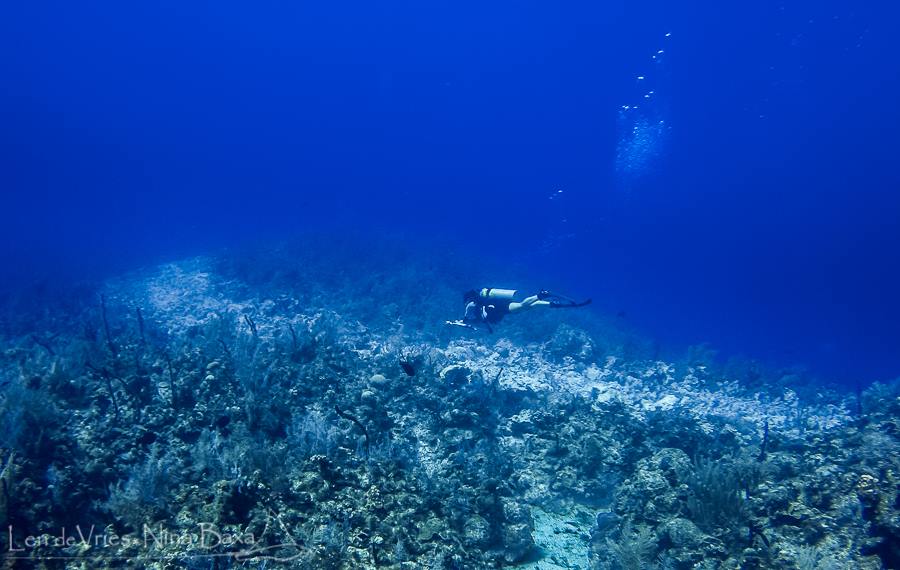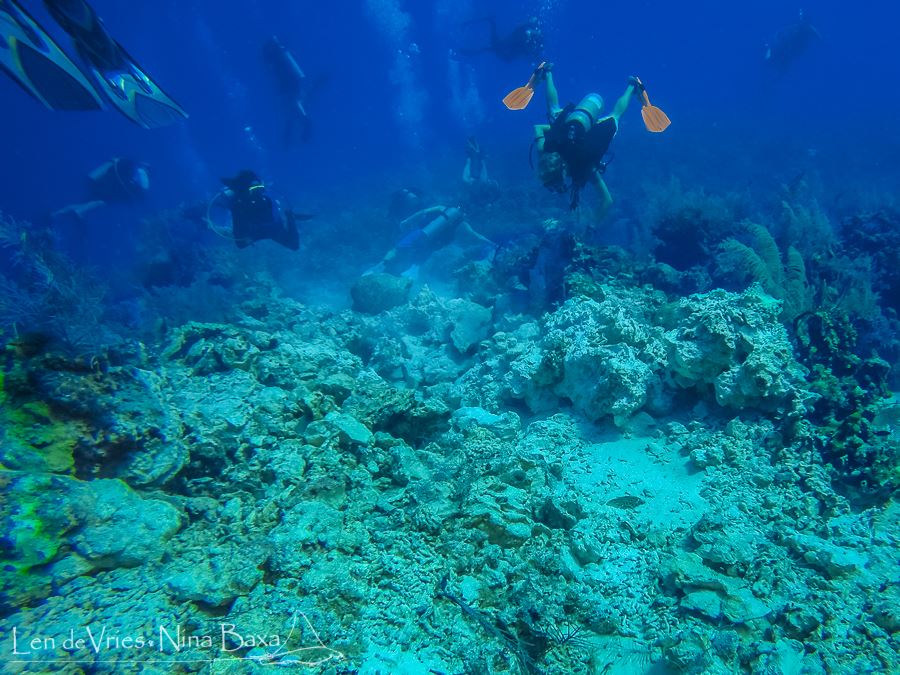Cayman Divers Restore Damaged Reef

In the waters off George Town, Grand Cayman, a group of approximately 50 volunteer divers led by local dive operators, and guided by the Cayman Islands Department of Environment (DOE), are working tirelessly to repair a coral reef severely damaged by a cruise ship anchor in mid-August. Working in teams with designated leaders, following project coordinators under the direction of the DOE, the divers are carefully removing the rubble, dead coral and sediment, crate by crate, knowing that time is critical.
“Right now it’s basic triage, and any live corals are being put aside for reattachment once the rubble is removed,” says Ocean Frontiers’ Lois Hatcher, who is trained and experienced in coral restoration. “Every day that goes by, more coral that is buried or heavily covered in sediment, is suffocating. They need sunlight and a stable substrate to survive, so the longer they are unstable, the survival rate decreases.”
Hatcher and Keith Sahm, Sunset House General Manager, are coordinating the structured project, guided by the Department of Environment. They are making sure the work is done carefully, methodically and safely. Both stepped up after they heard the news that the Carnival Magic accidentally dropped its anchor on the dive site. Frustrated by lack of immediate action, Sahm organized an emergency meeting September 18 at Sunset House and an overflow crowd of volunteers showed up motivated and ready to go to work knowing that time is critical and government manpower is short. Two days after the meeting, the volunteers made their first dive on the site, saw the extent of the damage and realized what they are up against.
“The chain damage is just terrible! The captain had let out 5 shots of chain – about 450 feet – with each link weighing between 50 – 100 pounds,” says Keith Sahm. “It’s a sickening feeling to know that thousands and thousands of years of coral growth has been demolished by an error in judgment, or mechanical problems.”
“A lot of man-hours are needed to restore a reef – first with the triage, then the reattachment and maintenance,” says Lois Hatcher, adding that it could take up to a year to complete. “We are also hoping to start a couple of nursery trees for the long-term keeping of live coral fragments, as they grow faster this way and can then be used to embellish what coral was replanted.
The goal is to execute a coral restoration project similar to the one carried out in 1996 when the Maasdam cruise ship dropped its anchor on a shallow dive site in George Town damaging 7500 square feet of the reef. That restoration project, conducted by local divers, including Lois Hatcher, and the Department of Environment, took about 9,000 hours of underwater work over three months. Officials say that coral bed could take more than sixty years to grow back. The Carnival Magic has damaged almost 12,000 square feet of reef located in deeper water, so the volunteer army has its work cut out for it.
“We are all just volunteers, so I applaud absolutely everyone’s effort here,” says Sahm. “Thank goodness we have folks like Peter Milburn and Lois Hatcher that worked on the 1996 project and are still here to help. And a special thanks to the Marine Conservation Board for easing guidelines and laws so we can do this restoration work – it’s unlawful for anyone to touch or pick up coral, dead or alive in the Cayman Islands. We wouldn’t be able to do this important work without the help of the Board and Department of Environment.”

The restoration work is difficult and exhausting, but everyone involved knows it will pay off in the years to come. While the dive site won’t be what it was originally, restoration can at least make the reef stable enough to sustain life again. The rubble also needs to be removed as soon as possible to prevent further damage when the next big storm kicks up.
While an investigation into the Carnival Magic incident is conducted, the repair work at the site continues non-stop and to date, more than a 20 dives have been made and volunteers have put in 150 man-hours. Communication and coordination are done through a Facebook page that now has 265 followers. Boat trips are scheduled and volunteers, both locals and visitors, can sign up to help. The challenge for Sahm and Hatcher will be keeping up the enthusiasm and pace of the repair work during the months ahead.
According to the Coral Restoration Foundation (CRF), a nonprofit conservation organization, the key to a successful project is to engage the community, something that is now taking place on Grand Cayman. Sunset House, Ocean Frontiers, Red Sail Sports, Divetech, Don Foster’s Dive and other local operators are providing boats and tanks for the dozens of volunteer divers. Southern Cross Club staff in Little Cayman will participate during an upcoming trip to Grand Cayman. Foster’s Food Fair, a local grocer, has donated the plastic milk crates being used to remove the rubble, while the local Subway has provided free sandwiches for the restoration crew. The hope, according to Sahm and Hatcher, is to encourage long-term involvement and partnerships that will keep the momentum going.
“This is something we really need to do as a community, try to repair the damage to this beautiful reef,” says Hatcher. “If nobody’s going to be held accountable for this, we have to be accountable for it.”
Team leaders and coordinators met with a Department of Environment officer on Monday for a project review, and the results according to the DOE, are encouraging because of the progress that has already been done.
The project has an on-going need for more volunteers and anyone interesting in helping is asked to visit the Facebook page Cayman Magic Reef Recovery where volunteer dives and updates are continually posted.
Source: The Cayman Bottom Times







